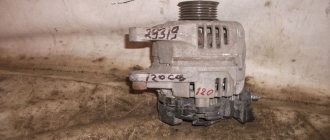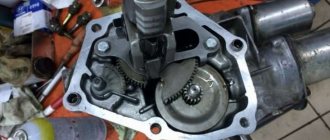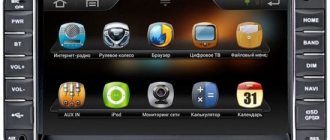Maintaining optimal engine temperature is one of the main factors influencing its duration and reliability. To prevent overheating of the power plant, a cooling system is used. Its working fluid is antifreeze. It serves to transfer heat from the engine to the radiator. When using high-quality coolant, not only reliable heat transfer is ensured, but also good protection of the elements of the cooling system circuit from deposits and corrosion. In this case, the liquid should not crystallize at low temperatures, as this can cause damage to the power plant.
Block diagram of the cooling system
Choice of antifreeze
To replace antifreeze on a Toyota Corolla vehicle, you need to select the appropriate one. For example, G11 is suitable for cars produced in the last century. Since the cooling system of this machine used metals such as:
- copper;
- brass;
- aluminum.
G11 has inorganic compounds that are not harmful to the old cooling system.
Technical fluid G 12 has been created for new radiators. But this is already an organic “anti-freeze”. Experienced mechanics do not recommend mixing organic and inorganic antifreeze. And Toyota Corolla modifications before 2000 cannot be filled with G12.
G 12 is otherwise called “Long Life”. Protects the metal surfaces of the system from:
- corrosion;
- oxide sedimentation.
Anti-freeze G 12 has a long service life. There are several varieties: G12+, G12++.
Liquids are also divided into three types:
- basic;
- nitrate-free;
- silicate-free.
Each of these types has individual characteristics, which, when mixed, can cause coagulation. Therefore, experienced mechanics advise not to mix different “anti-freeze” agents. And after the replacement period is due, it is better to flush the cooling radiator completely.
What else do experienced mechanics advise?
If the car owner is in doubt about what kind of coolant to pour into the system, he can find this information in the car’s operating book. And experienced mechanics and car owners advise the following:
- in Toyota Corolla before 2005, fill in Long Life Cooliant (belongs to the type of inorganic liquids G 11). Antifreeze catalog number 0888980015. It is red in color. It is recommended to dilute with deionized water in a 1:1 ratio;
- Super Long Life Cooliant (No. 0888980140) should be poured into the same make of car only after 2005. The cooler is of the G12+ grade.
Many car owners choose by color. It is not recommended to focus only on color. Because G11, for example, can be green, red and yellow.
The interval that should be observed when replacing antifreeze in a Toyota Corolla vehicle for cars manufactured before 2005 is 40,000 kilometers. And for modern cars, the interval has been increased to 100 thousand kilometers.
Attention! It is not recommended to add any foreign liquid to antifreezes for vehicles of recent years. This procedure will lead to precipitation, the formation of flakes, and deterioration of heat transfer.
If the car owner is going to use a third-party cooler, then the system must be thoroughly flushed before doing so. After pouring, it is recommended to drive the car and then check the color. If the antifreeze changes color to brownish-brown, it means the Toyota owner filled it with counterfeit products. It should be replaced urgently.
Properties of engine cooling fluids
During operation, the coolant heats up to 100 degrees and above, and when the car is parked, it cools down to ambient temperature. The efficiency of the cooling system and the durability of the power plant itself directly depend on the properties of antifreeze . Therefore, it must meet the following requirements:
- high heat capacity and thermal conductivity;
- mobility;
- low expansion coefficient and crystallization temperature;
- the product should not cause corrosion of metal surfaces, destroy rubber parts (seals and pipes) and foam during operation.
How does the fluid change procedure work?
Replacing antifreeze is carried out as follows:
- Place a container under the radiator to drain the waste.
- Wait until the engine cools down if the machine has been in working condition for a long time.
- Remove the cap from the expansion tank and open the heater tap.
- Unscrew the drain plug on the radiator and cylinder block.
- Wait until the waste drains completely.
- Tighten the drain plugs.
- Place a funnel in the filler hole and add fresh liquid.
Finally, you need to compress the inlet and outlet pipes. If the coolant level drops, you will need to add more. After this, you can screw on the cap of the expansion tank.
Now you need to start the Toyota Corolla engine and let it run for 5 minutes. Place the selector lever in position “P” on an automatic transmission or in the “Neutral” position if a manual transmission is installed. Press the gas pedal and bring the tachometer needle to 3000 rpm.
Repeat all steps 5 times. After this procedure, you need to check the anti-freeze level. If it drops again, you need to top it up.
Replacing antifreeze with your own hands
Replacing coolant in a Toyota Corolla is not particularly difficult and does not require the use of special tools. If necessary, this work can be easily done with your own hands, without going to a service station.
Step-by-step replacement:
- Place a pan or other container under the radiator and engine to drain the fluid;
- if necessary, wait for the engine to cool completely;
- remove the expansion tank cap;
- open the stove tap to maximum;
- unscrew the drain plugs on the cylinder block and radiator and wait until the contents have completely drained;
- screw in the plugs and tighten them with the required force;
- gradually pour new antifreeze into the expansion tank to the maximum level mark;
- Squeeze the radiator outlet and inlet pipes several times, and if the fluid level drops after this, add it to the required level;
- Reinstall the cap and valve onto the expansion tank.
After replacement, start and warm up the engine so that the thermostat opens and let the car run for 5-10 minutes. Press the gas pedal so that the revolutions rise to 3000, and keep the car in this mode for 1 minute. After this, the engine should idle for 30 seconds. This operation should be repeated 3-5 times so that the new composition is evenly distributed inside the cooling system.
After the engine has cooled, check the antifreeze level in the tank again and add it if necessary.
Replacing the coolant is carried out according to the instructions given below.
- Make sure the engine is cold. It is forbidden to replace antifreeze on a hot engine, as in this case there is a high risk of burns.
- Open the hood.
- Turn the expansion tank cap counterclockwise.
To prevent the engine from overheating during operation, as well as to prevent freezing of the fuel supply system in winter, a liquid such as antifreeze is used in cars. Replacing antifreeze in a Toyota Corolla 150 body, as well as in other models of this brand, has some features. This applies to the choice of coolant, in which certain rules must be followed to ensure efficient operation of the unit.
Safety precautions when changing the fluid yourself
If a car owner changes the anti-freeze system on his own and does it for the first time, then he should read what safety measures to take:
- Do not remove the cover while the machine engine is running. This can lead to the release of steam, which will burn human skin unprotected by clothing.
- If the coolant gets into your eyes, rinse with plenty of water.
- It is necessary to compress the cooling system pipes only while wearing gloves. Because they may be hot.
These rules will help maintain human health during replacement.
In what cases should antifreeze be replaced?
There is a planned replacement of antifreeze, caused by the gradual destruction of the additives included in its composition. As a result, the product begins to foam, the heat exchange process in the engine deteriorates, which can lead to overheating. Also, due to changes in the set of additives, parts in contact with the liquid may be destroyed.
On the packaging of each product there is information about its service life. This is what you should primarily be guided by when drawing up a replacement schedule. If, due to various factors, rapid “aging” of the coolant is observed, then replacement is carried out ahead of schedule.
The main signs that the composition has become unusable:
- a jelly-like mass appears on the surface of the expansion tank;
- in mild frosts, the contents of the expansion tank turn into a mushy state, or some sediment appears in it;
- frequent operation of the cooling system fan;
- contamination of the contents with foreign substances is visually noticeable;
- in case of an emergency, for example, if a hose burst on the road and you had to add water to the system.
When and why you need to change antifreeze
In addition to the antifreeze change intervals described above, it is necessary to replace it when the antifreeze deteriorates due to wear products accumulated in the system. If you do not pay attention in time, the engine or gearbox may overheat in the summer, and in winter, on the contrary, the fluid will harden. If the owner starts the car at this moment, the pressure may cause the pipes or radiator to burst.
Therefore, you need to change the “coolant” when:
- became brown, cloudy, faded. These are symptoms of waste fluid that will not protect the system as expected;
- the cooler foams, chips and scale appear;
- a refractometer or hydrometer shows negative values;
- the level of antifreeze decreases;
- a special test strip determines the liquid as unsuitable for use.
If the level drops, you should definitely check the expansion tank or radiator for cracks. Since liquid can only escape through holes resulting from the aging of the metal due to technical damage.
Attention! The boiling point of the coolant is 110 degrees Celsius with a plus sign. Withstands frosts down to minus 30 degrees. It all depends on the manufacturer and composition of the liquid. Chinese cheap fakes will not withstand the Russian operating conditions of a car.
Replacing antifreeze with your own hands
Replacing coolant in a Toyota Corolla is not particularly difficult and does not require the use of special tools. If necessary, this work can be easily done with your own hands, without going to a service station.
Step-by-step replacement:
- Place a pan or other container under the radiator and engine to drain the fluid;
- if necessary, wait for the engine to cool completely;
- remove the expansion tank cap;
- open the stove tap to maximum;
- unscrew the drain plugs on the cylinder block and radiator and wait until the contents have completely drained;
- screw in the plugs and tighten them with the required force;
- gradually pour new antifreeze into the expansion tank to the maximum level mark;
- Squeeze the radiator outlet and inlet pipes several times, and if the fluid level drops after this, add it to the required level;
- Reinstall the cap and valve onto the expansion tank.
After replacement, start and warm up the engine so that the thermostat opens and let the car run for 5-10 minutes. Press the gas pedal so that the revolutions rise to 3000, and keep the car in this mode for 1 minute. After this, the engine should idle for 30 seconds. This operation should be repeated 3-5 times so that the new composition is evenly distributed inside the cooling system.
After the engine has cooled, check the antifreeze level in the tank again and add it if necessary.
Application area
Toyota antifreeze is intended for servicing Japanese cars, trucks, and passenger cars, where class G12 is recommended. It is allowed to be poured into engines running on gasoline, diesel, biofuel with installed turbocharging, direct injection or exhaust cleaning structures.
Thanks to a well-thought-out formula, the composition does not freeze down to -35 degrees Celsius and maintains the necessary structure up to +110 °C.
Users note its suitability for pouring into agricultural, construction and highly specialized equipment, subject to the required tolerances.
Application area
If you are in doubt about what antifreeze to pour into a Toyota, you should always pay attention to the original one. After all, the manufacturer will not recommend anything bad for their cars. Toyota Long Life red antifreeze is suitable for both cars and trucks of this brand. Primarily designed for cars up to 2002. However, its use is also acceptable in newer models.
Other antifreeze from the Toyota line:
David, 52 years old I use new Toyota antifreeze, Super Long Life. It has a much more modern composition and higher quality than the simple one. Well, you can change it less often. Just don't mix it with anything.
Vadim, 46 years old I advise everyone to use a concentrate rather than a ready-made Super Long Life cooler. Why? Because the price, to be honest, is a bit steep, and the concentrate is much cheaper. In addition, it can be bred in accordance with your weather; if there are no severe frosts, it will be even cheaper.
Arthur, 37 years old Long Life is an excellent antifreeze for Toyota. Never thickens, foams or boils. I use it like I bought a car, and I see no point in experimenting and looking for something else.
Ivan, 35 years old I have been using the original Long Life in my Toyota for a long time. I can say that in the five years that I have had this car, I have never had any problems caused by antifreeze. The cooling system is in perfect order, as is the engine.
Timing for replacing coolant in Toyota Land Cruiser Prado 150
The coolant replacement period is not clear cut. The timing depends on the operating conditions of the machine, as well as on the properties of the coolant itself. Fluids of class G11 are recommended to be changed every 3 years, and G12 after 5 years. It is also recommended to change the coolant after covering 40 thousand km. If the engine operates under increased loads, the coolant also wears out faster.
Here are a few factors that influence antifreeze replacement:
- vehicle condition;
- mileage;
- coolant composition.
Antifreeze replacement in Toyota Land Cruiser Prado 150 is carried out under the following symptoms:
- cloudiness and loss of color;
- the appearance of foam and scale;
- separation of the liquid and the formation of white flakes in it;
A replacement will require about 9 liters of coolant.
Find the right oil for your Toyota
The right grade of oil is vital to keeping your Toyota engine running at its best. Your vehicle guide will confirm the correct rating for your vehicle and your region. Or use the official online tool to determine which oil you should use.
Engine oil
- this is not what you need to do. Using the right lubricant will keep your engine running smoothly and extend the life of your engine components. In fact, using the wrong grade of oil can be an expensive mistake.
This is especially true for diesels, which are very sensitive to the wrong brand. If you or anyone servicing your vehicle changes the diesel engine oil to the wrong type of lubricant, it may cause the diesel particulate filter to fail. To remedy this, you could look at a four-digit bill.
Motor oil: what do the numbers mean?
Motor oil is surrounded by a lot of numbers, letters, and jargon, which can make it difficult to find the right brand.
Essentially, you need to use oil of the recommended viscosity. This is the "thickness" of the oil and is usually displayed on the packaging. An oil with a high viscosity will be more molasses-like in consistency, while an oil with a low viscosity will be thinner and more pourable. Modern Toyota engines typically use low viscosity oils. They reduce engine friction, reduce wear and improve fuel economy.
The following table shows the recommended oil specifications for all current Toyota engine models and types.
| TOYOTA MODEL / ENGINE | RECOMMENDED GRADE OF ENGINE OIL |
| Aygo | 0W-16 |
| Yaris 1.0 | 0W-16 |
| Yaris 1.5 | 0W-20 |
| Yaris hybrid | 0W-20 |
| Corolla 1.2 t | 0W-20 |
| Corolla 1.8 Hybrid | 0W-16 |
| Corolla 2.0 Hybrid | 0W-16 |
| Camry | 0W-16 |
| C-HR 1.2t | 0W-20 |
| C-HR 1.8 hybrid | 0W-20 |
| RAV4 | 0W-16 |
| GT86 | 0W-20 |
| GR Supra | 0W-20 |
| Prius | 0W-16 |
| Prius plug-in | 0W-16 |
| Prius+ | 0W-20 |
| Land Cruiser (all) | 0W-30 |
| Hilux (all) | 0W-30 |
| Proace (all) | Contact your local Toyota center |
| Proace Verso (all) | Contact your local Toyota center |
Motor oil: how a specialist can help
When in doubt, contact your local Toyota Center for assistance. Our trained technicians and service advisors know Toyota vehicles inside out and can advise on the right oil for your vehicle and maintenance schedule (Proace and Proace Verso). Genuine Toyota engine oil was specially developed for our engines. You can't buy a better oil for your Toyota.
Whether you change your oil yourself or have a Toyota center do it for you, regular oil changes at the specified mileage or time are important. Even long-life oils become less efficient over time as repeated cycles of heating and cooling steadily degrade the oil.
Your local Toyota center is not the only place where you can buy genuine Toyota motor oil. Visit our eBay and you can order oil delivered to your home or office. Wherever you buy genuine Toyota motor oil, using the right grade is vital to maintaining your vehicle's performance, economy and reliability.
.
The correct way to drain/fill antifreeze 4.0
Really glad I have access to a coolant flush machine.
Not sure if this message will appear or not, but here is what alldata shows 1. DRAINING ENGINE COOLANT
WARNING: To reduce the risk of burns, do not remove the radiator cap while the engine and radiator are still hot. Thermal expansion will cause hot engine coolant and steam to escape from the radiator.
1. Remove the service hole cover from the engine bottom cover. 2. Install a vinyl hose to the drain on the radiator side. 3. Secure the vinyl hose with tape.
4. Loosen the 3 drain plugs on the engine and radiator and drain the coolant. 5. Remove the radiator cap. 6. Drain the coolant from the expansion tank. 7. Tighten the 3 drain plugs. Torque: 13 Nm (130 kgf-cm, 9 ft-lb) for engine 8. Remove the vinyl hose from the radiator.
2. ADD ENGINE COOLANT
1. Pour coolant into the radiator until it overflows.
Volume
NOTE:
*Using improper coolants may damage the engine cooling system. *Use only Toyota Super Long Life Coolant or similar high quality non-silicate, non-amine, non-nitrite and non-borate ethylene glycol coolant with long life hybrid organic acid technology (combinations of low phosphates and organic acids). * New Toyota vehicles are filled with Toyota Super Long Life Coolant (pink color, pre-mixed ethylene glycol concentration is approximately 50%, and the freezing point is -35 °C (-31 °F)). When replacing coolant, it is recommended to use Toyota Super Long Life Coolant.
WARNING: Do not replace engine coolant with plain water.
2. Check the coolant level inside the radiator by squeezing the radiator inlet and outlet hoses several times with your hand. If the coolant level drops, add coolant. 3. Install the radiator cap securely. 4. Slowly pour coolant into the radiator reservoir until it reaches the FULL mark. 5. Warm up the engine until the cooling fan starts running.
(1) Set the air conditioner as shown in the illustration while warming up the engine. (2) Maintain engine speed between 2000 and 2500 rpm and warm up the engine until the cooling fan starts running.
6. Squeeze the radiator inlet and outlet hoses several times with your hand while warming up the engine. 7. Stop the engine and wait until the coolant cools down. 8. Remove the radiator cap and check the coolant level inside the radiator. 9. If the coolant level is below full level, perform steps (a) through (h) and repeat until the coolant level remains at full level. Recheck the coolant level in the radiator reservoir. If the level is below full, add coolant.
3. CHECK FOR COOLANT LEAKS
1. Fill the radiator with coolant and attach the radiator cap tester. 2. Bleed it to 118 kPa (1.2 kgf-cm2 17.1 psi), then check for leakage.
.
What to choose
Now we can discuss what kind of antifreeze to pour into Toyota. There is also no definite answer to this question, since each car owner will advise his own option. The most optimal and safest way is to use coolant according to the recommendations for your foreign cars; it recommends using a silicate-free liquid with an organic corrosion inhibitor based on propylene glycol.
Original Toyota products meet these requirements:
- LongLifeCoolant (LLC) red;
- Super Long Life Coolant (S LLC) pink;
There is a universal antifreeze. It is better, of course, to fill Toyota with the original composition, but if funds do not allow, you can use a high-quality substitute.
How to spot a fake
Information on the canister labels
It cannot be said that original antifreezes, suitable only for one brand of car, are counterfeited as often as the most popular, universal, branded coolants are often counterfeited. However, this is not completely ruled out. Therefore, the coolant canister must be carefully inspected. Here are some signs that may indicate a fake:
- rough, uneven seams or defects in their area;
- a lid that does not fit tightly to the ring, scratches, chips, and other signs of tampering along its edges;
- unevenly glued labels, bubbles and folds on them, traces of glue;
- information that does not correspond to reality or contains errors;
- blurred text, uneven lines;
- unreadable release and bottling date.
If something in the appearance of the canister is alarming or raises doubts, then it is better to double-check. You should not pour antifreeze into the tank until you are completely sure of its quality.
Why change the coolant?
It is necessary to change the used coolant in your car regularly. Why? Here it is worth going a little deeper into the chemical composition. The main component of the substance is ethylene glycol or propylene glycol (less common due to its high cost). Substances are famous for their extremely low freezing point (crystallization) and have a low expansion coefficient when transitioning from liquid to solid.
At the same time, ethylene glycol promotes corrosion during prolonged interactions with metal components, especially aluminum.
The latter are highly susceptible to the aggressive effects of the compound. To make the antifreeze less volatile, the composition also includes:
It is the minor elements that lose their properties over time, activating the “destructive” properties of ethylene glycol. And if the car owner does not monitor the health of the radiator, and exhaust gases get inside it, then the protective properties of antifreeze/antifreeze disappear ahead of time. The second reason is the mixing of formulations from different manufacturers and grades.
The key point is adding ordinary water to Antifreeze, which many people do. Often, regular tap water is poured in rather than distillate, which significantly increases the freezing point and increases the susceptibility of metal parts to corrosion. This procedure can help in the summer at a critical moment, but not in the winter. Antifreeze diluted with water thickens greatly in the cold and is no longer able to protect the radiator.
Long Life Coolant Toyota – is replacement possible?
This antifreeze is not an inexpensive alternative: it was simply replaced in 2002 by LLC with the Super prefix. Until this time, Toyota engines were filled with “ordinary” Long Life Coolant in red color.
Despite the same base and similar additive package, the liquids are incompatible with each other. However, switching from red antifreeze to pink is possible, but only after flushing the system.
The quality of antifreeze is similar: the new generation has become a little more environmentally friendly and retains factory settings longer. Feedback from drivers who made the transition to the new generation of coolers did not reveal any fundamental differences.











